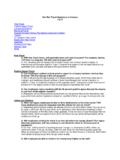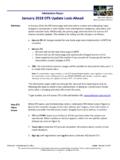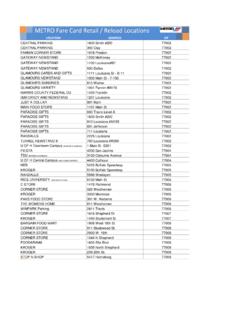Transcription of The Sabre Story
1 The Sabre StoryA chance meeting on an airline flight that turned into the technology leader for the travel bre /s br /:Semi Automated Business Research Environment Prior to Sabre , airline agents took reservations in person at airports or ticket offices, or on the phone, where they hand-wrote cards and organized them in lazy susans like the one here. This was error-prone and inefficient, causing airplanes to be over-and under-booked, which was very costly to the airlines and often very inconvenient for foundations for what is now the leading technology company powering the travel industry began with a chance encounter on a coast-to-coast flight in the earliest days of the jet age. It was 1953, the airline industry had seen a growth in air travel following World War II, and airlines were struggling to manage the link between airline inventory and passenger reservations. This resulted in inaccuracies that drove flights to be frequently over-or under-booked, passenger service issues, and underutilized aircraft.
2 Smith, president of American airlines , and R. Blair Smith, a senior sales representative for IBM, met on an American airlines flight from Los Angeles to New York. Their conversation about the travel industry sparked the idea for a data processing system that could create and manage airline seat reservations and instantly make that data available electronically to any agent at any location. The two companies studied the feasibility of building such a system for five years, ending with an agreement between American airlines and IBM to build out the specifications for the industry s first passenger name record or PNR system. The system was built by IBM based on technology created at MIT for the SAGE (Semi-Automatic Ground Environment) air-defense project. American airlines named its system Sabre , or Semi-Automated Business Research Environment. The success of Sabre prompted IBM to build its own system to market to airlines , named PARS Programmed Airline Reservations System.
3 This brought the realization among the major carriers that their operations also required a similar system, triggering a wave of airline automation that would last through the decade, and truly transform the airline industry, as electronic reservations systems provided important new efficiencies in the distribution of airlines product. Eventually, a new category developed within the travel industry the Customer Reservations System (CRS). Later CRS technology was leveraged into Global Distribution Systems (GDS). Sabre has retained its position as an industry leader and innovator in both the airline hosting and global distribution was fully operational in 1964, a year before any other airline had an installed reservations automation system, and demonstrated to the industry that real-time processing was a feasible and realistic solution to the passenger reservations problem. The first Sabre system was installed on two IBM 7090 computers, located in a specially designed computer center in Briarcliff Manor, NY.
4 The initial research, development and installation investment in this system took 400 man-years of effort at a development cost of almost US $40 million. The state-of-the-art mainframe system processed 84,000 telephone transactions per day. AIRLINE AUTOMATION IS BORN1960-1969 The initial Sabre system had two IBM 7090 mainframe computers, connected to 1,500 terminals across the and Canada. The system was housed in Briarcliff Manor, April 1976, Robert Crandall had moved from Finance become the Senior Vice President of Marketing, and the first Sabre terminals, and first automated reservations terminals in the industry, were installed in travel agent offices. Approximately 130 travel agent offices had the system by the end of the EXTERNAL1970-1979 Sabre led the next phase of technology innovation in the airline business when it implemented a program to take computing to the travel agent 1972, the American Society of Travel Agents (ASTA) saw that the airlines had gained productivity through automation, but the travel agencies were still largely manual and were reliant upon calling the airlines to make reservations for their customers.
5 ASTA had a strong desire to have a common, integrated travel agency system that would allow agencies to take advantage of the same efficiencies the airlines saw through automation. Without the needed support for an industry solution, Max Hopper, who was now responsible for Sabre at American, with the backing of American s new Senior Vice President of Finance, Robert Crandall, prepared to make the Sabre system available to travel agencies. Robert L. Crandall - 1989 Technology advances like the creation of multiprocessor systems, had the ability to handle a large fares database, and a large communications network became part of the Sabre systemThe Airline Deregulation Act of 1978 changed the landscape for airlines , which now had more opportunities to take actions like adding and deleting routes and changing fares. But with opportunity came new threats and challenges, and customers were no longer just looking for available seats, but were looking for available seats at the best price.
6 This drove the usage of the systems up, drove reservations and ticket office costs higher, and incented the airlines to transition more of the reservations to travel agents. With that transition, technical innovation was critical to keeping up with demand, and technology advances like the creation of multiprocessor systems, the ability to handle a large fares database, and a large communications network became part of the Sabre Sabre was primarily focused on corporate customers, easySabre was offered via online services, which enabled consumers to access the Sabre system directly. Using personal computers, consumers could access airline, hotel and car rental information and make their own reservations. Sabre Airline Solutions released the industry s first revenue management system, increasing airline revenue by optimizing the fare at which each seat was sold, then further advancing revenue management with the invention of virtual and continuous nesting concepts, which are still in use today.
7 By the end of the decade, Sabre s software and systems management had positioned American airlines as one of the most technologically advanced airlines in the world, and Sabre started taking that technology to the marketplace, providing software, consulting, and systems management services to other the end of the decade Sabre was running on over 130,000 travel agency terminals ADVANTAGE1980-1989 As technology advanced and the impact of deregulation progressed, Sabre continued to innovate and bring industry-defining capabilities to American introduced BargainFinder pricing, which automatically provided the lowest fare for a given itinerary, a service that was unmatched in the industry but welcomed as fare pricing became more dynamic, adding complexity for travel agents trying to find the lowest fare for their customers. During this time, the Sabre system expanded to store 36 million fares, which could be combined to create more than 1 billion fare options.
8 By the end of the decade Sabre was running on over 130,000 travel agency terminals : Sabre has a global presence with primary locations around the COUNTRIES 9,500+ PEOPLE 3 DEVELOPMENT CENTERSD allas/Fort Worth, TexasBethesda, MarylandBangalore, IndiaLondon, EnglandKrakow, PolandSao Paulo, BrazilMontevideo, UruguayBuenos Aires, ArgentinaSingaporeSydney, AustraliaThe Travelocity name was the combination of the two words, travel and velocity, to indicate speed in booking travel. The original logo with the plane flying up was intended to portray a fast journey through the Travelocity booking system. Technology was also moving forward. The World Wide Web became a viable channel, and the possibility of using the internet to market and sell to consumers outside of the online services like CompuServe and The Source became a embraced this new capability, and was the first Global Distribution System (GDS) to create a consumer-facing online booking engine.
9 Travelocity launched on March 12, 1996. It soon had over million registered members and began logging about 15 million hits was also expanding its services, forming a joint venture with ABACUS international including an agreement for Sabre to provide a customized version of its reservations system to 7,300 subscribers in Asia. This positioned Sabre as the market-share leader in electronic travel distribution in the Asia Pacific region and worldwide. In another bold move, Sabre signed a hosting agreement with US Airways, and in December of 1998 successfully transitioned approximately 200 US Airways systems to Sabre systems, the largest systems migration in the history of the airline industry. To round out the decade, William Hannigan became the Chairman and Chief Executive Officer of Sabre in early 90s were an exciting time for Sabre as American airlines was starting to see Sabre as a much larger asset than just an internal IT group.
10 In 1993, American airlines combined the internal technology teams to form The Sabre Technology Group, and pioneered another first when Kathy Misunas was named CEO one of the first female CEOs in the technology 1996, AMR Corp. the parent company of American airlines made The Sabre Group a separate subsidiary of AMR and did an initial public offering of Sabre stock, with AMR as the majority owner. At this time, leadership of Sabre transitioned to Michael Durham, who moved from his position as Chief Financial Officer of American HORIZONS1990-1999 Big advances were also made to airline products throughout the 2000s. Sabre introduced SabreSonic Customer Sales and Service (CSS) creating the industry s first real intersection of customer-focused solutions and revenue generation across every distribution channel. Sabresconic married the high availability platform and core capabilities already present in the Sabre system with graphical user interfaces, reservations with full customer insight, airline alliance and partnering tools, complete departure control, inventory, online booking, shopping, pricing and interline e-ticketing sales and service, there was significant innovation in airline operations products.







